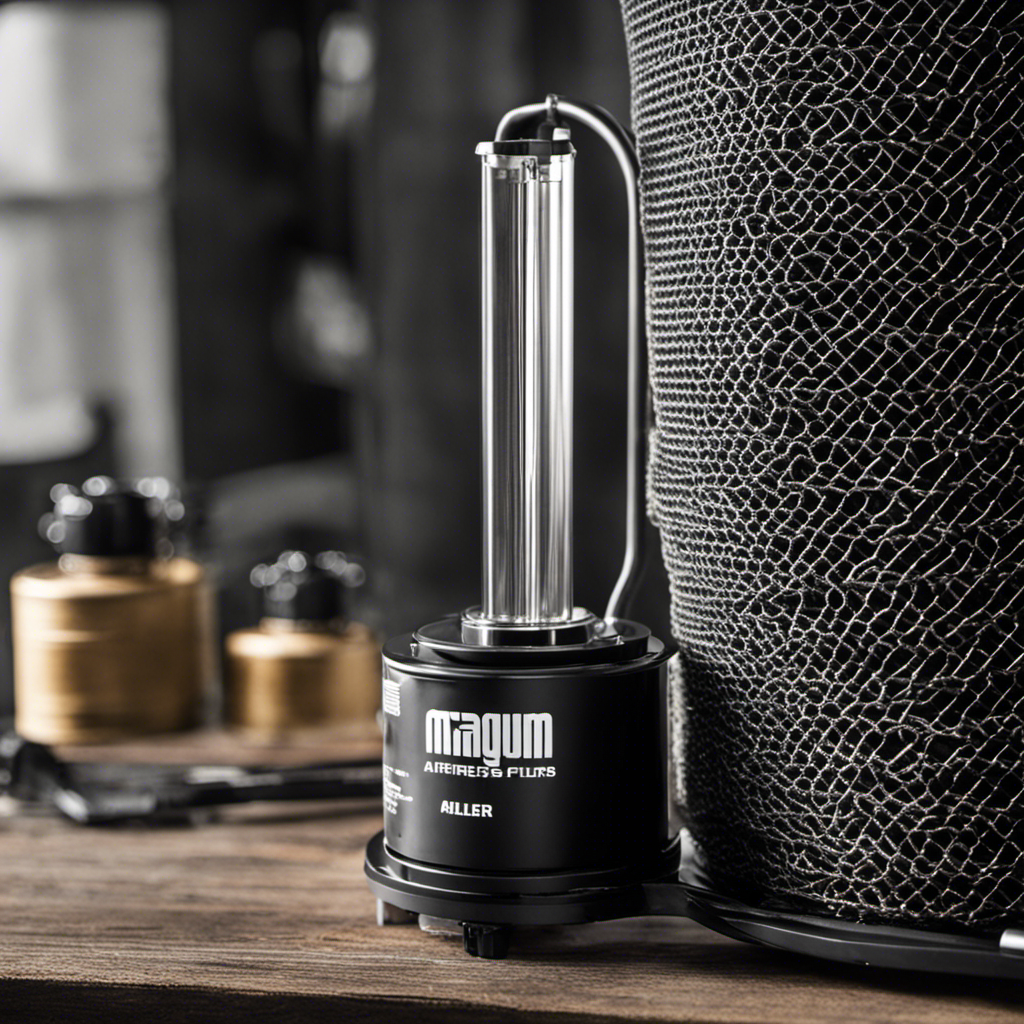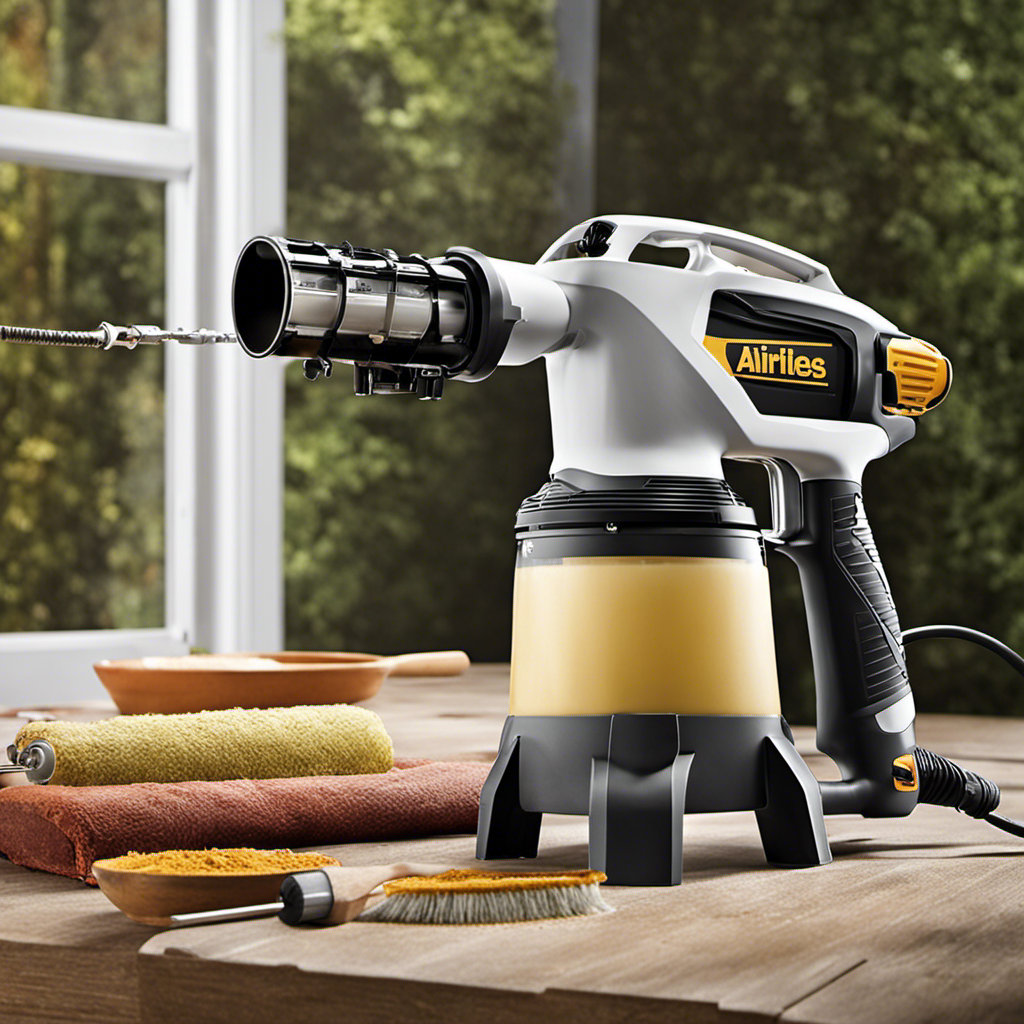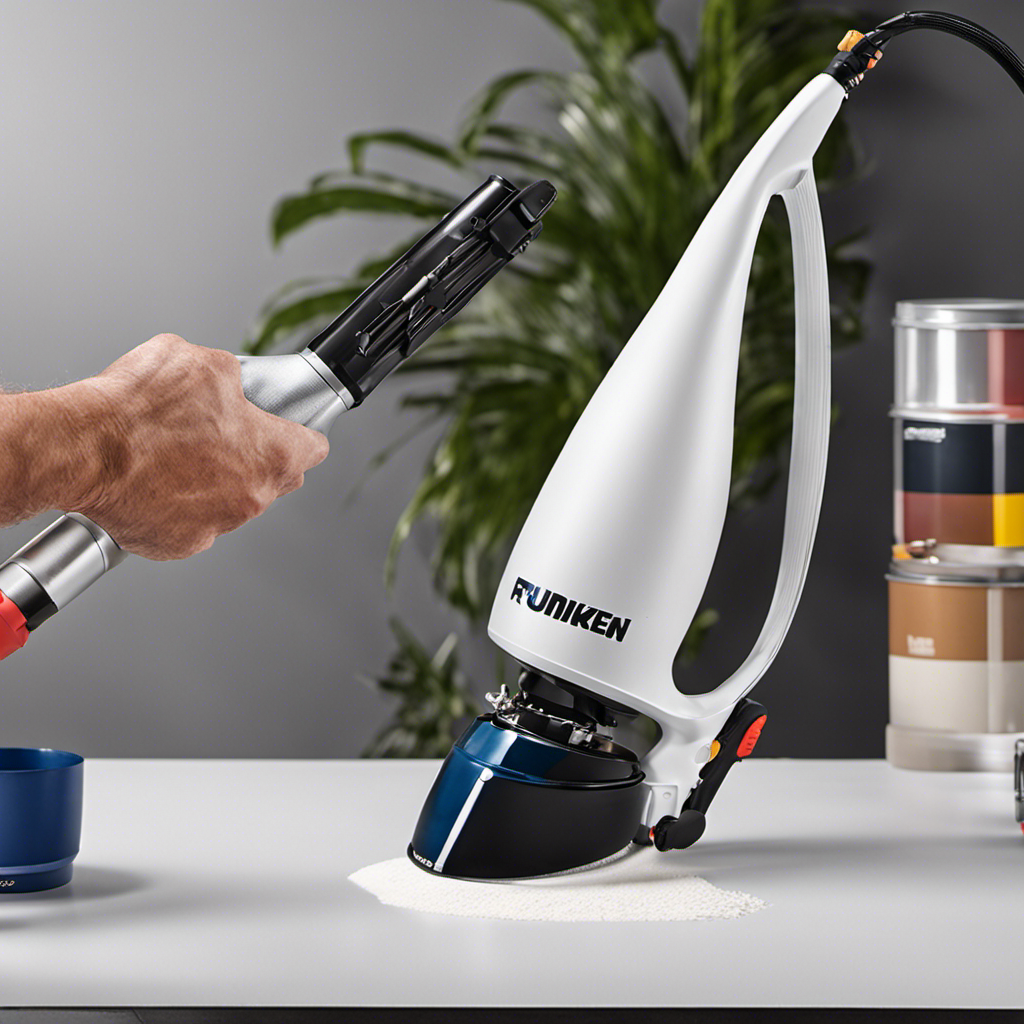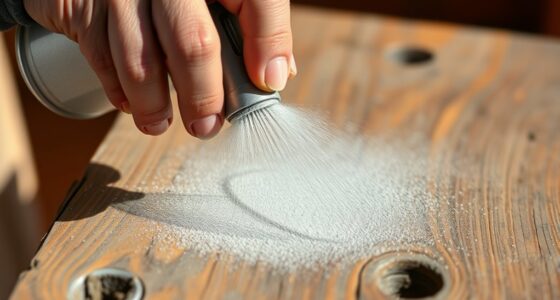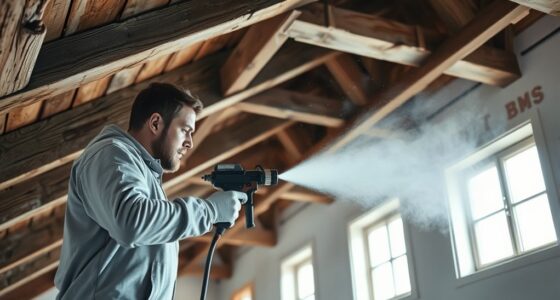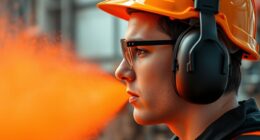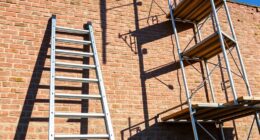The performance of any painting project is heavily reliant on the effectiveness of the Magnum Airless Paint Sprayer, with the filter being the unsung hero at its core. This element plays a crucial role in maintaining a clean, debris-free paint flow, essential for achieving impeccable results. The filter is essential in preventing blockages and guaranteeing a seamless finish, highlighting its significance as a key component of the device.
In this article, we will delve into the importance of filters in the Magnum Airless Paint Sprayer and explore the techniques for proper maintenance and upgrading for optimal performance.
Key Takeaways
- Investing in high-quality filters is crucial for the longevity and durability of the Magnum Airless Paint Sprayer.
- Proper filtration ensures clean and debris-free paint flow, resulting in a smooth and even spray.
- Regularly cleaning and maintaining filters is essential for optimal performance and longevity.
- Choosing the right filters enhances the efficiency and effectiveness of your Magnum sprayer.
The Significance of Proper Filtration
Proper filtration ensures clean and debris-free paint flow, resulting in a smooth and even spray. The benefits of proper filtration in the Magnum Airless Paint Sprayer are numerous.
By using long-lasting filters, impurities and contaminants are effectively removed from the paint, preventing clogs and ensuring professional finishes. Clean and debris-free paint not only saves time during painting projects but also reduces frustration.
Filters are crucial in achieving optimal performance and efficiency with the Magnum airless paint sprayer. Using filters improves spray performance, reduces nozzle clogging, and extends the equipment’s life.
Ensuring Clean and Debris-Free Paint Flow
To achieve a smooth and even spray, users should regularly clean and maintain their filters in the Magnum Airless Paint Sprayer to ensure clean and debris-free paint flow. Regular filter maintenance offers several benefits, including improved performance, longer filter lifespan, and enhanced paint coverage.
Clean filters prevent clogs and blockages, ensuring optimal paint flow and spray performance. This leads to professional finishes and improved paint coverage. Regular maintenance extends the life of filters, reducing the need for frequent replacement.
Choosing the right filter size is also crucial for effective filtration and paint application. The mesh size determines the level of filtration, and selecting the appropriate filter material ensures compatibility and performance.
Preventing Clogs and Achieving Professional Finishes
Regular maintenance and cleaning of the filters in the Magnum Airless Paint Sprayer help prevent clogs and ensure professional finishes.
Proper filtration is crucial for achieving optimal performance and efficiency. By removing impurities and contaminants, filters prevent clogs and ensure a smooth and even spray. Clean paint flow not only saves time and frustration during painting projects but also improves spray performance and extends the life of the equipment.
It is important to choose the right filters, considering size and material, to ensure proper filtration and paint application. Regular inspection, cleaning, and replacement of filters, if necessary, are essential for optimal performance.
Troubleshooting filter issues and maintaining filters through proper care and cleaning help prevent painting problems and save time and money in the long run.
Time-Saving Benefits of Clean and Debris-Free Paint
Achieving a clean and debris-free paint flow saves time and frustration during painting projects, resulting in more efficient and satisfying results.
- Benefits of clean and debris-free paint:
- Time-saving: With a clean and debris-free paint flow, painters can maintain a steady and uninterrupted workflow, saving valuable time.
- Improved efficiency: Clean paint ensures smooth and even coverage, reducing the need for touch-ups and rework.
- Enhanced results: By eliminating debris, the final finish is professional-looking and visually appealing, leading to greater customer satisfaction.
By investing in high-quality filters for the Magnum Airless Paint Sprayer, painters can experience these time-saving benefits. Proper filtration removes impurities and contaminants, preventing clogs and ensuring a consistent paint flow.
Regularly cleaning and maintaining the filters is essential for optimal performance and longevity. With clean and debris-free paint, painters can complete projects more efficiently and achieve superior results.
Improving Performance and Efficiency With Filters
By properly maintaining and upgrading their filters, painters can significantly enhance the performance and efficiency of their Magnum airless paint sprayer. Filters play a crucial role in increasing durability and maximizing paint coverage. These filters ensure a clean and debris-free paint flow, resulting in a smooth and even spray.
By removing impurities and contaminants, filters prevent clogs and ensure professional finishes. Clean and debris-free paint not only saves time during painting projects but also improves the overall quality of the final result. Regular inspection, cleaning, and replacement of filters when necessary are essential for optimal performance and longevity.
Choosing the right filter size and material, as well as upgrading to high-quality filters, can further enhance the efficiency and effectiveness of the Magnum airless paint sprayer. Proper care and maintenance of filters are crucial for impeccable painting results and improved efficiency.
Locating and Cleaning Filters in the Magnum Airless Paint Sprayer
When maintaining the Magnum airless paint sprayer, painters can easily locate and clean the filters in two main areas: the suction tube and the spray gun.
Regular filter maintenance is of utmost importance for the optimal performance and longevity of the equipment. By using high-quality filters, painters can enjoy several benefits, including a smooth and even spray, prevention of clogs and blockages, and time-saving during painting projects.
Cleaning the filters removes dirt, dust, and particles, ensuring uninterrupted paint flow. It is essential to regularly inspect and clean the filters, as well as replace them if necessary, to maintain optimal performance. Proper filter maintenance not only extends the life of the Magnum airless paint sprayer but also improves spray performance and reduces nozzle clogging.
The Suction Tube and Spray Gun Filter Locations
Painters can easily locate the filters in the suction tube and spray gun of the Magnum airless paint sprayer. Regular filter maintenance is of utmost importance for optimal performance and longevity.
Using high-quality filters offers several benefits, such as ensuring clean and debris-free paint flow, resulting in a smooth and even spray. Filters remove impurities and contaminants, preventing clogs and ensuring professional finishes.
The suction tube filter is situated at the bottom of the paint container, while the spray gun filter is located near the trigger. Regularly inspecting and cleaning these filters, as well as replacing them if necessary, is crucial for maintaining optimal performance.
Effective Techniques for Cleaning Filters
Regularly cleaning and maintaining the filters in the suction tube and spray gun of the Magnum airless paint sprayer is essential for optimal performance and longevity. Here are some effective cleaning techniques and maintenance tips to ensure the filters are in top condition:
-
Clean the suction tube filter by removing the container and unscrewing the filter housing. Soak the spray gun filter in a cleaning solution.
-
Regularly inspect and clean the filters to remove dirt, dust, and particles that can cause clogs and blockages.
-
Troubleshoot filter issues by thoroughly cleaning them or replacing damaged or worn-out filters.
-
Choose the right filter size and material based on the manufacturer’s recommendations for proper compatibility and performance.
-
Upgrade filters to enhance paint flow and improve coverage, ensuring efficient and effective painting.
-
Maintain filters after each use, looking out for tears or holes, to prevent clogs and affect the spray pattern.
Don’t neglect filters for impeccable painting results. Follow these cleaning techniques and maintenance tips to ensure optimal performance and longevity.
Regular Inspection and Maintenance for Optimal Performance
Regular inspection and maintenance are essential for ensuring optimal performance and extending the life of the Magnum Airless Paint Sprayer. By regularly inspecting the filters, users can identify any signs of wear or damage, such as tears or holes, and promptly address them. This proactive approach prevents clogs and blockages that can affect the spray pattern and overall performance of the sprayer.
Furthermore, regular maintenance, including thorough cleaning after each use, removes dirt, dust, and particles that may accumulate in the filters over time. By keeping the filters clean and in good condition, users can maximize the efficiency and longevity of their Magnum Airless Paint Sprayer.
Neglecting regular maintenance can lead to reduced performance, increased downtime, and the need for premature replacement of equipment, highlighting the importance of regular maintenance for extending the life of the sprayer.
Troubleshooting and Maintenance of Filters
When troubleshooting and maintaining the filters in the Magnum Airless Paint Sprayer, users should ensure they are cleaning the filters thoroughly after each use and promptly addressing any signs of wear or damage. This is important to ensure optimal performance and prevent painting problems.
To evoke emotion in the audience, consider the following:
- Frustration: Clogged filters can cause frustration and delays during painting projects.
- Efficiency: Regular maintenance and troubleshooting techniques improve filter efficiency, saving time and money in the long run.
- Longevity: Proper care and cleaning of filters extend their lifespan, ensuring consistent performance and professional finishes.
Tips for Choosing and Upgrading Filters for the Magnum Airless Paint Sprayer
After understanding the importance of troubleshooting and maintaining filters in the Magnum Airless Paint Sprayer, it is crucial to focus on selecting and upgrading filters to optimize its performance. When choosing filter material, it is essential to consider the level of filtration required and the compatibility with the sprayer. To assist in this process, manufacturers often provide recommendations regarding the appropriate filter size and material. Upgrading filters offers numerous benefits, including enhanced paint flow, improved paint coverage, and increased painting efficiency. High-quality filters also tend to have a longer lifespan, resulting in cost savings in the long run. By choosing and upgrading filters, users can ensure that their Magnum Airless Paint Sprayer operates at its best, delivering impeccable painting results.
| Choosing Filter Material | Benefits of Upgraded Filters |
|---|---|
| Consider level of filtration | Enhanced paint flow |
| Check compatibility with sprayer | Improved paint coverage |
| Consult manufacturer’s recommendations | Increased painting efficiency |
| Longer lifespan |
Frequently Asked Questions
What Is the Recommended Frequency for Cleaning the Filters in the Magnum Airless Paint Sprayer?
The recommended cleaning frequency for filters in the Magnum Airless Paint Sprayer is after every use.
Proper cleaning solutions should be used to ensure thorough removal of dirt, dust, and particles.
Cleaning the filters regularly prevents clogs and blockages, maintaining optimal performance.
Neglecting filter maintenance can affect the spray pattern and overall painting results.
Can I Use Any Cleaning Solution for Soaking the Spray Gun Filter, or Are There Specific Recommendations?
When it comes to soaking the spray gun filter in the Magnum Airless Paint Sprayer, it’s important to choose compatible cleaning solutions.
While there may be alternative cleaning methods, it’s recommended to follow the manufacturer’s guidelines for the appropriate cleaning solution.
Using the wrong cleaning solution could potentially damage the filter or affect its performance.
Therefore, it’s crucial to choose a cleaning solution that is specifically recommended for soaking the spray gun filter to ensure optimal cleaning and maintenance.
Are There Any Specific Signs or Symptoms That Indicate a Clogged Filter in the Magnum Airless Paint Sprayer?
Signs of a clogged filter in the Magnum Airless Paint Sprayer include reduced paint flow, uneven spray patterns, and increased pressure fluctuations.
Cleaning techniques, such as removing and soaking the filters in a cleaning solution, are crucial for preventing clogged filters.
Regular inspection, maintenance, and replacement of filters when necessary are essential to ensure optimal performance and prevent painting problems.
Are There Any Alternative Methods for Cleaning the Filters if I Don’t Have Access to a Cleaning Solution?
If access to a cleaning solution is limited, there are alternative methods for cleaning the filters of the Magnum Airless Paint Sprayer.
One method is to use warm soapy water to soak and gently scrub the filters.
Another option is to use a mild household detergent or vinegar solution to dissolve any paint residue.
It is important to rinse the filters thoroughly after cleaning to ensure all debris is removed.
Regular filter cleaning is of utmost importance to maintain optimal performance and prevent clogs in the paint sprayer.
Besides the Manufacturer’s Recommendations, Are There Any Other Factors to Consider When Choosing Upgraded Filters for the Magnum Airless Paint Sprayer?
When choosing upgraded filters for the Magnum Airless Paint Sprayer, there are several factors to consider.
Firstly, one should consider the mesh size of the filter, as it determines the level of filtration.
Additionally, the material of the filter is crucial for proper compatibility and performance.
Upgraded filters offer benefits such as enhanced paint flow and improved paint coverage.
They also have a longer lifespan and improve painting efficiency.
Considering these factors ensures optimal performance and longevity of the paint sprayer.
Conclusion
In conclusion, the importance of filters in the Magnum Airless Paint Sprayer cannot be overstated. These filters act as the gatekeepers, ensuring a smooth and even spray by removing impurities and contaminants from the paint flow. They prevent clogs, enhance performance, and achieve professional finishes.
Just like a vigilant guard, regular inspection and maintenance of filters are crucial for optimal performance. Choosing the right filter size and material is like selecting the perfect tool for the job.
So, remember to treat your filters with care and watch as they effortlessly transform your painting experience into a masterpiece.
Franz came aboard the Paint Sprayer Zone team with a background in both journalism and home renovation. His articulate writing style, combined with a passion for DIY projects, makes him an invaluable asset. Franz has a knack for breaking down technical jargon into easy-to-understand content, ensuring that even the most novice of readers can grasp the complexities of paint sprayers.
